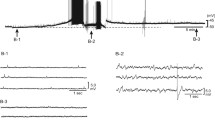Abstract
Postganglionic compound action potential (AP) and intracellular NAD(P)H-fluorescence were recorded simultaneously in the perifused superior cervical ganglion of the rat (SCG) to study the effects of the bispyridinium oximes HGG12, HGG42 and obidoxime.
HGG12 and HGG42 inhibit the compound action potential (AP) (ID50: 70 μM) and the reductive part of NAD(P)H changes (ID50: 75 μM) recorded upon stimulation of the SCG, while obidoxime has no ganglion blocking effects in concentrations up to 1 mM.
The effects of inhibitors of cholinergic transmission were also studied in order to understand the mechanism of action of the oximes. Hexamethonium (C6) and atropine, competitive inhibitors of receptors of nicotinic and muscarinic cholinergic transmission respectively, were found to block synaptic transmission (C6 ID50: 150 μM, atropine ID50: 70 μM) and the reductive part of the NAD(P)H response (C6 ID50: 70 μM, atropine ID50: 50 μM) in a quantitatively similar way.
Comparison of the ganglionic action of HGG12 and HGG42 with that of the inhibitory agents characterises them as inhibitors of receptors of nicotinic ganglionic transmission. Furthermore at concentrations of about 10 μM, HGG12 behaves like atropine and leads to an increase in AP and reductive fluorescence response. It is therefore probable that HGG12 has in addition an affinity for ganglionic muscarinic receptors which HGG42 does not have.
Similar content being viewed by others
Abbreviations
- SCG:
-
superior cervical ganglion
- AP:
-
fast postganglionic action potential
- pAP:
-
action potential of presynaptic nerve endings
- EPSP:
-
excitatory postsynaptic potential
- mR:
-
metabolic response as indicated by the change of NAD(P)H-fluorescence after electrical stimulation
- C6:
-
hexamethonium bromide
- OP:
-
organophosphates
- ID50:
-
inhibitory concentration for 50% of AP or integrated mR
References
Amitai G, Kloog Y, Balderman D, Sokolovsky M (1979) The interaction of bis-pyridinium oximes with mouse brain muscarinic receptor. Biochem Pharmacol 29: 483–488
Brauser B, Bücher Th, Dolvio M (1970) Redoxtransitions of cytochromes and pyridine nucleotides upon stimulation of an isolated rat ganglion. FEBS Lett 8: 297
Bull RJ, Lutkenhoff SD (1973) Early changes in respiration, aerobic glycolysis and cellular NAD(P)H in slices of rat cerebral cortex exposed to elevated concentrations of potassium. J Neurochem 21: 913–922
Chance B (1976) Pyridine nucleotide as an indicator of the oxygen requirements for energy-linked functions of mitochondria. Circ Res [Suppl] 38: 31–38
Dunant Y (1967) Organisation topographique et fonctionelle du ganglion superieur chez le rat. J Physiol (Paris) 59: 17
Dunant Y (1968) Presynaptic spike and excitatory postsynaptic potential in sympathetic ganglion. Their modification by pharmacological agents. Prog Brain Res 31: 131
Dunant Y, Dolivo M (1967) Relations entre les potentiels synaptiques lents et l'excitabilité du ganglion sympathetique chez le rat. J Physiol (Paris) 59: 281
Dunant Y, Dolivo M (1968) Plasticity of synaptic functions in the excised superior cervical ganglion of the rat. Brain Res 10: 271
Eccles RM, Libet B (1961) Origin and blockage of synaptic responses of curarized sympathetic ganglia. J Phys (London) 157: 484
Hauser W, Weger N (1979) Therapeutic effects of the Bis-pyridinium salts HGG12, HGG42 and atropine, benactyzine in organophosphate poisoning of dogs. Arch Toxicol [Supp] 2: 393–396
Kirsch D, Weger N (1979) Effects of soman and Bispyridiniumoximes on the isolated circumfused s.c.g. of the rat. Arch Pharmacol [Suppl] 307: R 24
Larrabee MG, Horowicz P, Stekiel W, Dolivo M (1956) Metabolism in relation to function in mammalian sympathetic ganglia. In: Richter D (ed) Metabolism of the nervous system. Pergamon Press, Oxford, p 908
Lundy PM, Tremblay KP (1979) Ganglion blocking properties of some bispyridinium soman antagonists. Eur J Pharmacol 60: 47–57
Nilwises N, Schmidt G (1965) Wirkungen von Atropinverbindungen auf die synaptische Übertragung im isolierten Cervicalganglion der Ratte. Arch Exp Pathol Pharmacol 251: 335
Author information
Authors and Affiliations
Rights and permissions
About this article
Cite this article
Kirsch, D.M., Weger, N. Effects of the bispyridinium compounds HGG12, HGG42, and obidoxime on synaptic transmission and NAD(P)H-fluorescence in the superior cervical ganglion of the rat in vitro. Arch Toxicol 47, 217–232 (1981). https://doi.org/10.1007/BF00368682
Received:
Issue Date:
DOI: https://doi.org/10.1007/BF00368682



